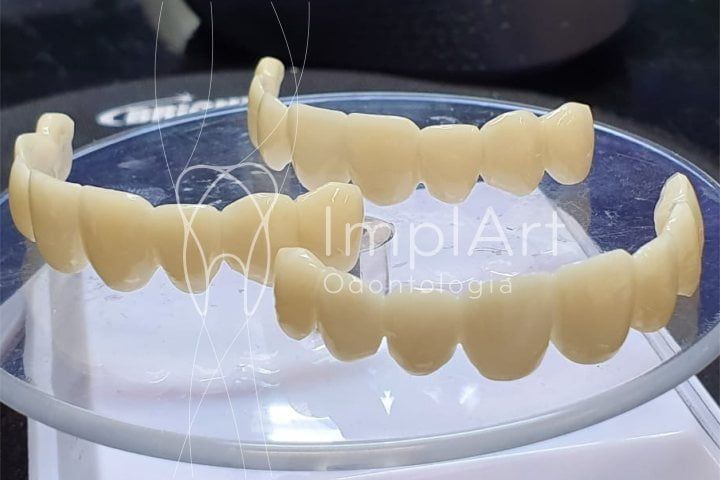
Temporary teeth 3D Printed : how and why they are used
Temporary teeth, also known as “provisionals” or temporary crowns, have undergone important developments over time. However, until recently provisional prostheses were made without the need for perfection in aesthetics and adaptation, as they would be replaced by permanent dental prostheses.
All about 3D Printed Temporary Teeth /Provisionals
What are temporary teeth for?
Temporary prostheses now allow you to “visualize” the final result of your design or treatment, from something as simple as a crown to an oral rehabilitation of all teeth.
Provisionals today serve as prototypes for permanent restorations and allow you to make a better decision about the size, shape, appearance, function and color of your final restorations.
Temporaries have become an important and necessary part of any smile or bite reconstruction. They serve several other important functions, including:
- Protect teeth that have been prepared for a final restoration.
- Cover exposed dentin to prevent tooth sensitivity, plaque build-up, cavities and pulp problems.
- Prevent unwanted tooth movement.
- Allow patients to eat and speak normally.
- Maintaining the health and contours of the gum tissue.
- Allow patients to test the fit, appearance, comfort and function of their smile makeover or early restoration.
- To serve as an example and aesthetic reference when discussing the case with the patient.
- Allow functional or bite problems to be solved during the intermediate period in which they are worn.
- Save time and money by providing an exact plan of what the final restorations will look like, thus reducing the need for additional procedures, adjustments and remakes.
Find out about our new coronavirus measures at the ImplArt Clinic
Do I have to get a temporary one? Or can I do without?
Temporary teeth: crowns, bridges, fixed or removable prostheses are important for intermediate stages at the dentist. Unless you’re having a one-day treatment (Day Clinic), you’ll always need a temporary dental prosthesis.
The following types of crowns require a provisional version: metal-ceramic porcelain crown, zirconia porcelain crown, pure zirconia crown, emax crown, crown on implant, fixed prosthesis for dental implant, full arch implant, all on 4 prosthesis, immediate loading on implants, dental contact lenses.
When are provisionals needed?
If you choose to have a treatment, a temporary restoration is placed on the prepared teeth which offers protection, comfort and aesthetics while you wait for the final restoration to be made and placed.
Temporaries are used while you have crowns, bridges, inlays, onlays and porcelain veneers made for you and sometimes even for removable partial dentures, complete dentures and implant treatment.
Temporary restorations are especially important when several teeth have to be prepared, or when occlusal (bite) or cosmetic changes are foreseen. It is easier to adjust temporary acrylic resin restorations than to modify final permanent restorations made from metal, zirconia, ceramic or metal-ceramic materials.
Here at the ImplArt Clinic we use Digital Dentistry CAD / CAM technology (computer-aided design / computer-aided manufacturing). We can create your restorations in your office – create, bond and fit the permanent restoration in just one session, thus eliminating the need for temporaries.
Temporary restorations are also necessary when there is little or no removal of tooth enamel during the final placement of some porcelain veneers, as may be the case with some types of porcelain veneers (with little or no wear), such as dental contact lenses and ceramic laminates.
The time needed to use a temporary varies from a few days (short term) for simple cases, such as a single crown, to several weeks (medium term) for cases such as inlays, onlays and veneers. Provisionals are required for several months (long-term) for complex cases, such as full mouth reconstruction.
How are temporary crowns made?
They can be done using a direct or indirect technique. A direct technique is performed chairside (in the mouth) by your dentist. An indirect technique requires taking a mold (with putty or an intraoral scanner) of your mouth and making your temporaries outside your mouth and/or in an external laboratory.
When provisionals will need to be used for the long term or as diagnostic tools, laboratory-made provisionals are generally better because their materials provide greater strength and are more resistant to wear and discoloration.
As they more closely resemble the final result of treatment, lab-made temporaries also give you and your dentist a more accurate idea of whether you will be able – or want – to live with permanent restorations in this shape, design and fit.
If your permanent restorations are fabricated in an external dental laboratory, the dentist will make a mold of the teeth to be restored. Molds or digital images of your smile are sent to the laboratory, where a three-dimensional simulation of the desired aesthetic proposal or smile restoration is made.
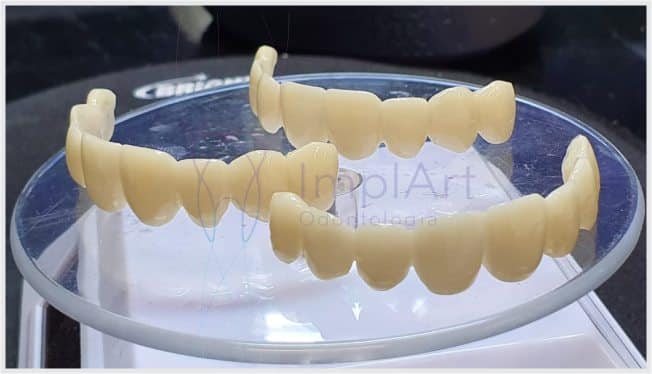
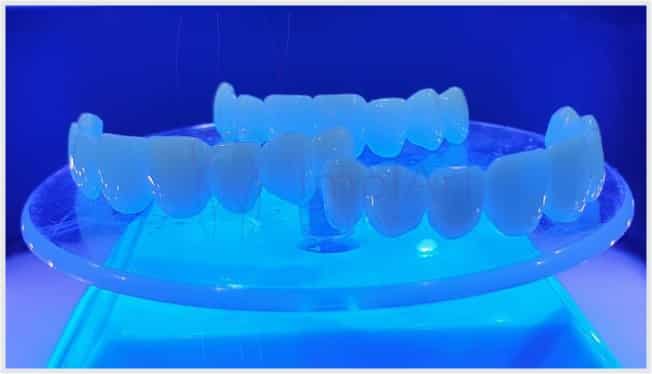
The planning is returned to your dentist so that you can approve the shape, contours and appearance of the proposed treatment together with him. Once the treatment has been approved, your teeth are prepared for the final restorations.
Once the provisionals have been made, your dentist will install the teeth using a temporary cement (glue).
If changes need to be made to the bite or shape of the temporary crown, these can also be made at any time.
Materials used in provisional prostheses
Temporary restorations can be made using different materials. We will select the most suitable material for you, based on your treatment plan and taking into account how long you will need to wear it.
The materials used in the dental office to make provisional restorations include prefabricated acrylic (plastic) crowns, self-curing resins, light-curing resins, bisacrylic resins, composite resins, ceramics and, more recently, resins for 3D printing and resins for computerized milling.
Temporaries made in the laboratory are generally made of acrylic, but the ones we use most (at ImpLArt Clinic) are 3D-printed and those made by milling machines.
Materials for a temporary tooth should be strong, wear-resistant, natural-looking, with good color stability, easily adjustable and capable of producing temporaries with a good fit along the gum line.
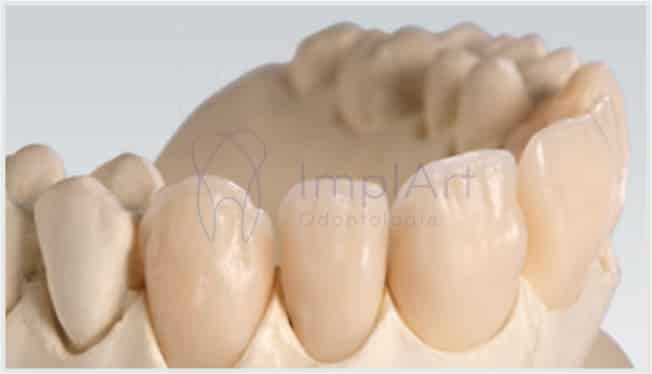
Placing and removing provisionals
It’s very important that your provisionals are secure and stable in place. If they fall out, the prepared teeth can shift position and this can cause a change in the way the final and permanent restorations fit together.
Therefore, if your temporary falls out or you have a problem, call your dentist to schedule a brief appointment to have it re-cemented or replaced. Temporary crowns are typically bonded using temporary cement.
The temporary cements that dentists use generally have a soft, creamy consistency and come with a modifier used to loosen the cement when removing them.
When the temporaries are loose enough, your dentist will use finger pressure or an instrument such as tweezers to carefully remove them.
Can the provisional fall? Can it break?
When a temporary crown breaks, it should be replaced quickly. Both to protect the tooth below the crown and to avoid the aesthetic discomfort of having a broken tooth.
How much do temporary prostheses cost?
Generally, there is no separate charge for temporaries, as temporary restorations are a necessary part of many dental treatment procedures.
However, the cost of the temporary depends on different factors, including whether they were made in the dental office by the dentist or created by an external laboratory, the materials used to make them, the types and number of adjustments that may be needed, whether the temporaries are for one tooth or several.
An important cost consideration is how long the temporaries need to be in the mouth. For example, if the temporary is a denture or bridge with a dental implant, it may need to remain in place for six months to a year.
This is sometimes called a “long-term” temporary. In addition, if provisionals are used for aesthetics only, the dental insurance will generally not cover the costs associated with them.
For a more specific estimate, you should discuss the figures with your dentist in consultation. For example, consider that most cases of oral rehabilitation or smile design involve diagnostic planning in order to determine the best way to improve a person’s smile.
Dentists usually charge for this service, and these models can later be used to create temporaries.
How to use temps to view Smile Test Drives
As well as serving a functional purpose, temporary restorations also offer a preview of the final treatment result. If necessary, you can ask your dentist for adjustments to the length of the teeth, shape, color and aesthetics.
Your dentist will technically adjust the temporaries for optimal comfort and functionality, as well as testing your ability to speak naturally. When you and the dentist are satisfied, a new impression will be taken of the 3D-print-approved temporary restorations.
The prototype model of your approved temporaries will then be sent to the dental laboratory, where your final restorations will be fabricated according to this “model”.
In our clinic this is even easier as we work with computerized technologies, so all you have to do is reprint the projected tooth in the new definitive material, whether it’s vitroceramic porcelain or dental zirconia.
In certain clinical situations, temporary restorations can be used to visualize the final results without wearing down the teeth. If you decide that the proposed treatment is not suitable for you, neither you nor your dentist will commit to wearing down the tooth.
In other situations (if there is tooth decay), your teeth should be restored before the temporary ones are made.
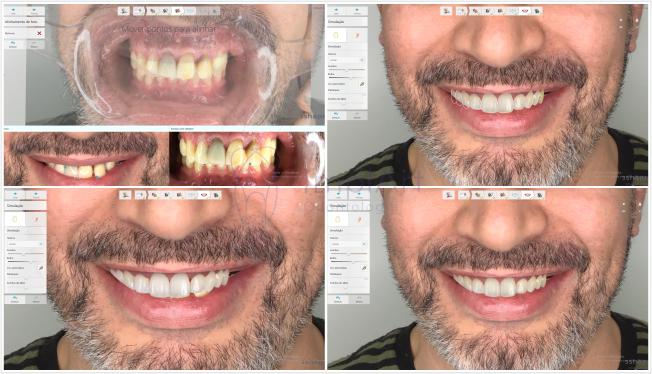
Smile test drive or teeth mockup
A trial smile is a removable acrylic device used during the pre-treatment phase to give you and the dental team a clearer understanding of the expectations for the final result.
To allow you to see the potential result of the proposed restoration in three-dimensional form, a diagnostic wax-up is created and a removable test smile that you can wear in your mouth is made with this wax-up.
In our clinic, this result is planned using computerized models. An experimental smile is made from 3D-printed acrylic.
Once modeled and fabricated, the experimental smile is placed in the mouth. This allows you to instantly visualize, feel and test the result of your new smile with temporary teeth before undergoing permanent tooth preparation.
If you like the expected result, you can choose to continue with the treatment plan. After accepting the treatment, the next step is to get temporaries for the teeth involved.
Temporary prostheses: concerns, care and travel considerations
Provisionals are designed to restore teeth, usually for a short temporary period.
Although today’s temps are realistic, natural and durable, it’s common for some people to have problems with their temps.
Common concerns with temps include:
- Temporaries can have a rough feeling that can be irritating to your tongue.
- They fall easily.
- Teeth with temporary crowns are more sensitive to heat and cold.
- It’s harder to chew.
- You’re not happy with the way the temps look.
- Temporaries can cause bad breath if they are not cleaned properly.
Take care of your provisionals
To face as few problems as possible with your temporary teeth, following the care instructions below can be helpful:
- Don’t eat or drink anything hot for at least an hour after your temporaries have been fitted.
- So if you feel sensitivity in your gum tissue and teeth, take a mild painkiller and anti-inflammatory according to the instructions. Call your dentist if the discomfort doesn’t subside or gets worse.
- Rinse with warm water and salt (1/2 teaspoon of salt in a four-ounce glass) for a few days after placing the temporary to help reduce gum sensitivity.
- Avoid sticky foods such as toffee, caramel or chewing gum, as they can dislodge the temporary product.
- When brushing your teeth, use a soft-bristled brush to gently massage the gum tissue.
- Still floss daily, but pull the floss along the sides of your teeth instead of upwards.
- To avoid breakages, don’t chew hard substances such as nuts, ice, peanuts or pencils. If possible, chew on the opposite side of your mouth.
I’m going on a trip and I still have temporary crowns, what should I do?
Depending on the procedure you are undergoing, it may be necessary to remain in São Paulo until the end of a stage of the work or until the final conclusion (rapid treatments in DayClinic).
During this treatment you may need (or want) to wear temporaries / temporary teeth.
Also make sure you discuss this with your dentist before starting any procedure, so that he can schedule the fabrication of your temporaries in time for your trip.
Satisfactory temporaries are especially important when travelling away from the dentist, as it can be more difficult to see the dentist if there are problems with fit, function or the temporary falling out.
Also, if you’re planning a vacation or business trip, complete any necessary dental work before you leave.
If this isn’t possible and you need to use provisional or temporary teeth, let your dentist know your travel plans as far in advance as possible, as this may affect the type of temporaries he will make for you and the strength of the cement used to adhere them.
Before your departure, schedule a preventive check of your temporaries to minimize the possibility of dental emergencies while you’re away.
Watch our videos on digital dentistry and talk to us if you have any questions.
 Agende sua consulta agora por WhatsApp
Agende sua consulta agora por WhatsApp
Leave a Reply